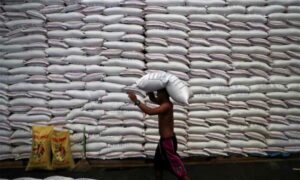Letter from China: China’s premium rice farms regain vitality after last summer flood

In Heilongjiang, China’s leading grain province, paddy fields thrive despite previous typhoon devastation. Liu Xiu, aided by government support, rebuilds after floods, now employing cooperative farming and social media for organic rice. Meanwhile, Qiaofudayuan Agricultural Co. Ltd. pioneers high-quality rice production with innovative methods, including duck-deployed fields and precision weather monitoring. Despite impressive grain output, experts seek further yield enhancements.
HARBIN, May 30 (Xinhua) — It is late in May, and paddy fields are featuring tender green rice seedlings in northeast China’s Heilongjiang Province, the country’s top grain producer.
Rice in the fields of Heilongjiang grow for more than 130 days until the October harvest period, which is longer than the growth cycle of paddy rice growing elsewhere in China, and yield the country’s premium rice.
An hour’s drive from the provincial capital of Harbin, which recently hosted the eighth China-Russia Expo, vast swathes of black soil farmlands and paddy fields provide ideal conditions for grain production. The paddy rice growing area of Wuchang, a city administrated by Harbin, is regarded as Heilongjiang’s premier area for growing high-quality rice.
Walking along the edge of fields, I could barely imagine how Typhoon Doksuri had devastated this rice-producing area in August 2023. The typhoon triggered rare and significant floods just as rice plants began to form ears, leaving paddy fields inundated.
“The flood water submerged my seedling greenhouse and destroyed my house,” said Liu Xiu, 66, as she explained the severity of the damage caused by last summer’s flooding in her village of Changbao, Wuchang.
According to the city’s agricultural department, nearly half of Wuchang’s 2.5 million mu (about 166,667 hectares) of rice growing fields had suffered flood damage.
Local authorities responded swiftly to the disaster, helping 2,651 households rebuild their houses, and another 8,259 households repair their houses, before the start of winter.
Liu and her son spent the winter in their newly built houses equipped with underfloor heating systems. Rebuilding of their houses was made possible by government subsidies, she said.
“Last year, my fields yielded no harvest due to the disaster. This spring, I spent nearly a whole month removing flood sludge and rubbish from the fields, and then poured clean water on the land for planting,” Liu said.
Irrigation water reaches her field through pipes running from a river section 50 km away. All flood-damaged irrigation systems in Wuchang had been repaired before May to ensure the possibility of spring farming.
Liu and her son manage a 130-mu paddy field. This takes the form of a rural cooperative, with seven other rural households having transferred their land to the cooperative farming initiative.
With the help of a transplanting machine equipped with satellite navigation, Liu and her son managed to independently plant the seedlings in the vast field within two weeks.
A friend helped her register an account on the social media platform Douyin, China’s version of TikTok, and uploaded video clips showing how she worked in the field. Her account has garnered 60,000 followers.
Confident of the success of this year’s harvest, Liu invited me to return in autumn for a taste of her crop. “Many of my fans placed orders after watching my farming activities on Douyin. I offer them a discounted price for advance orders,” she revealed.
“We only produce organic rice, and use biological methods for pest control and hand-made bean cakes as fertilizer,” Liu added.
According to the Heilongjiang provincial department of agriculture and rural affairs, the province has made every effort to maximize the prime planting season. As of May 26, the transplanting of rice seedlings had been completed in 99 percent of the paddy fields in Heilongjiang.
Among the hundreds of rice-producing firms in Wuchang, Qiaofudayuan Agricultural Co. Ltd. is seen as a flagship company in the field of high-quality rice production, contracting farmland owned by 8,000 households for cooperative farming.
Huang Changming, manager of the company’s planting management department, said except for 40 mu (about 2.67 hectares) of paddy fields reserved for visitors to experience rice seedling planting, the company had finished its seedling planting for the 2024 season.
Every year, the company receives about 10,000 primary school students, who visit it to study agriculture and experience farm work.
The company has 30,000 mu of certified organic rice fields, where manual seedling transplanting has been maintained for intensive farming aimed at producing rice of premium quality, said Huang.
“When the seedling plants grow to 30 cm tall, we deploy duck chicks in the field at a density of 18 chicks per mu on average. The duck chicks eat weeds and pests in the field, without disturbing rice plants, which have barbs. In addition, duck manure fertilizes the field,” Huang explained.
The company’s rice brands mostly cater to high-end consumption demands in China. Its best organic rice resulting from the duck-deployed fields is priced at 1,489 yuan (about 209 U.S. dollars) per 300 grams.
Huang also said that the company had installed intelligent weather stations in paddy fields for precision weather monitoring, thereby allowing it to adopt swift measures to prevent or limit damage caused by adverse weather.
“These measures proved effective in preventing flood damage last year. In case of heavy rainfall forecasts, we timeously drained water from fields,” said Huang.
As the country’s major grain-producing province, Heilongjiang pays very close attention to farming production, taking all steps of the process seriously in its bid to achieve a bumper harvest.
The province’s grain output amounted to 77.88 billion kg in 2023, extending its hold on the number one ranking in China to 14 consecutive years. Nonetheless, agricultural experts believe that the per-unit yield of grain crops in the province still has room for improvement.
Source Link : https://english.news.cn/20240530/cdf1cee4890a4eaa9efce95da652572a/c.html














